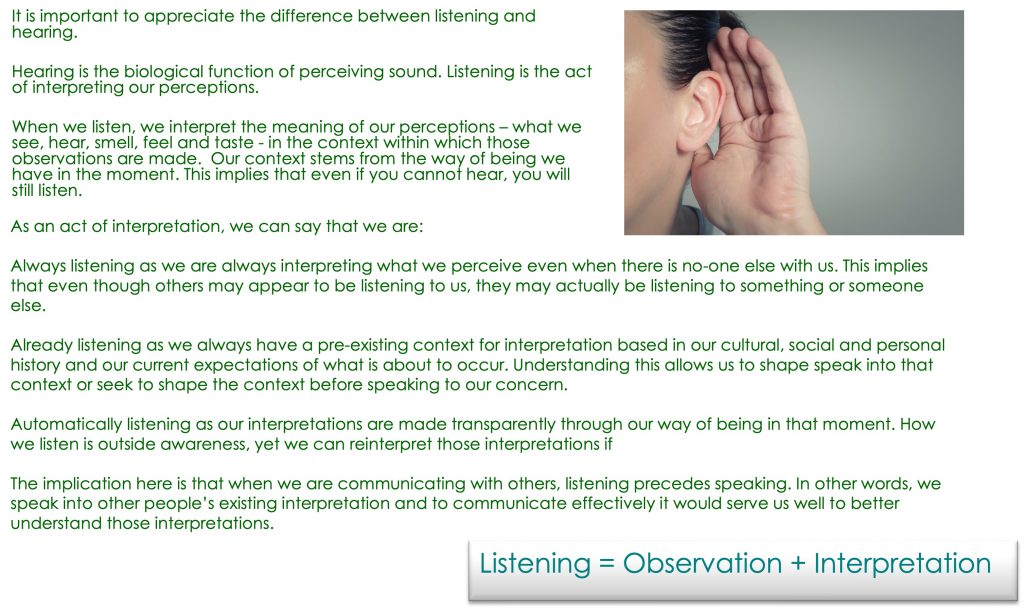
This approach is based on a new understanding of language where language is seen as action. This interpretation provides us with a new way of looking at the phenomenon of listening.
J.L.Austin, a British philosopher who was one of the first people to identify language as an active process, identified three primary levels of action when we speak.
The action of uttering the words is what Austin termed ‘locutionary acts’. This is the action of saying what we say and relates to the combination of the words we use to bring forth certain listening. For example, to say “I am bored” is different to saying, “I have got nothing to do“, even though we may interpret what is meant in the same way.
‘Illocutionary acts’ is the level of the general linguistic acts such as assertions, assessments and declarations. (See the document ‘The Domain of Language’ for more about this)
Finally there are ‘perlocutionary acts’ which is the action involved in the speaking. For instance, if I am requested to attend a meeting and I say “yes“, then others will listen to a future action where I will attend a meeting.
In listening we attend all three levels of action – the words and how they are said, the linguistic actions and the ensuing actions. However, this is still doesn’t fully explain the process of listening. When we listen, we also apply meaning beyond what was said. For example, if my son asks me “Can I buy a television?“, then I might also listen to him asking for some assistance in making the purchase. Or if I ring a friend and leave a voicemail message asking them to have lunch with me and I get no reply, I might listen to them being upset with me.
In other words, we do not only listen to the words and what we observe, we generate meaning out of our concerns. Hence listening as an act of interpretation not only involves what is observed, but also the context in which it is observed.
To also better understand how we listen, it is also useful to appreciate that the traditionally action is intentional. Although this can be the case, more often than not action is habitual rather than intentional. This approach follows the lead of German philosopher, Martin Heidegger with the claim that when ever we act, we do so to take care of something – a ‘concern’. Concerns are what are important to us and lie at the heart of what we do. Indeed, sometimes we are clear about the reasons we do what we do, but this often masks what we are truly addressing with our actions.
For instance, when I go with my daughter to the movies, my intention might be to do something she loves, but what is at the heart of this is a concern for our relationship. When we go to the movies, I most likely do not go through a thought process of considering that I will do this because our relationship is important to me. This concern is so transparent to me that it does not show up in my thoughts about whether I go to the movies or not. Yet when I look behind my action, this is a fundamental basis for that action.
The difference between concerns and intentions is subtle but significant. If we expect there to be intention behind every action, then how do we deal with people who say they do not know why they did something? We may well be led to conclude they are lying. However, by recognising they are taking care of some unseen concern, the same answer opens up a different field of inquiry. We can explore what they took care of when they did what they did.
This is where listening comes to the fore. We do not intentionally listen – listening is a transparent action. We do not consciously consider how we listen, we just do. We listen in a way that seeks to address our own concerns so we can make sense of the world as we observe it. Our own listening is a window to our own concerns.
A useful framework for this approach to listening is termed ‘The Three ‘A’s of Listening’:
1. Automatic Listening (Transparent Listening)
We listen transparently or automatically. We cannot help how we listen, we just do. As a result, we cannot say people are not listening properly. They might not be listening as we intend, but they will listen as their current way of being allows. If we want to ensure we are listened to as we intend, then that responsibility lives with us and we will need to check others’ interpretations of our words and adjust if need be.
2. Already Listening (Context)
Whenever we speak, we do so into another’s context, what is termed their ‘Already Listening’. Stephen Covey identified one of the habits of highly effective people as “Seek first to understand, then to be understood”. Seeking to understand others ‘already listening’ provides us the chance to generate a context more conducive with taking care of our own concerns and generating greater shared meaning.
3. Always Listening (Constant Meaning Making)
Given listening is the generation of meaning and we are constantly making sense of the world, it can be said people are ‘Always Listening’. It might be that they are not listening to you when you speak, but they are still listening to something. For instance, when I speak to someone, they might want to watch tv and their listening might be “I wish they would go away and leave me alone”. Hence one of the keys to effective conversation lies in ensuring those people to whom we are speaking are listening to us.
